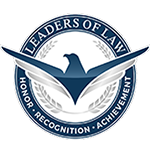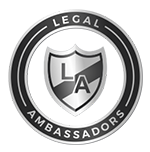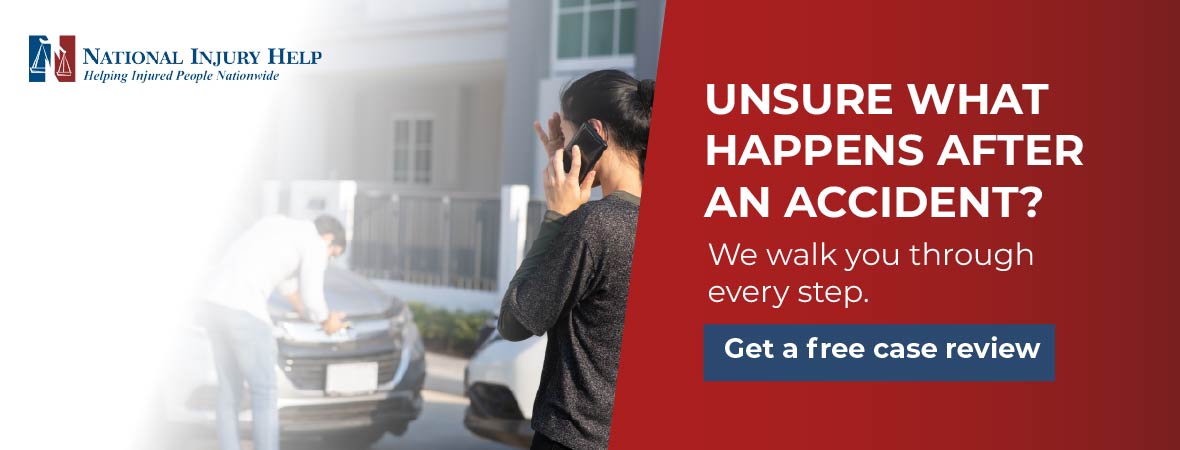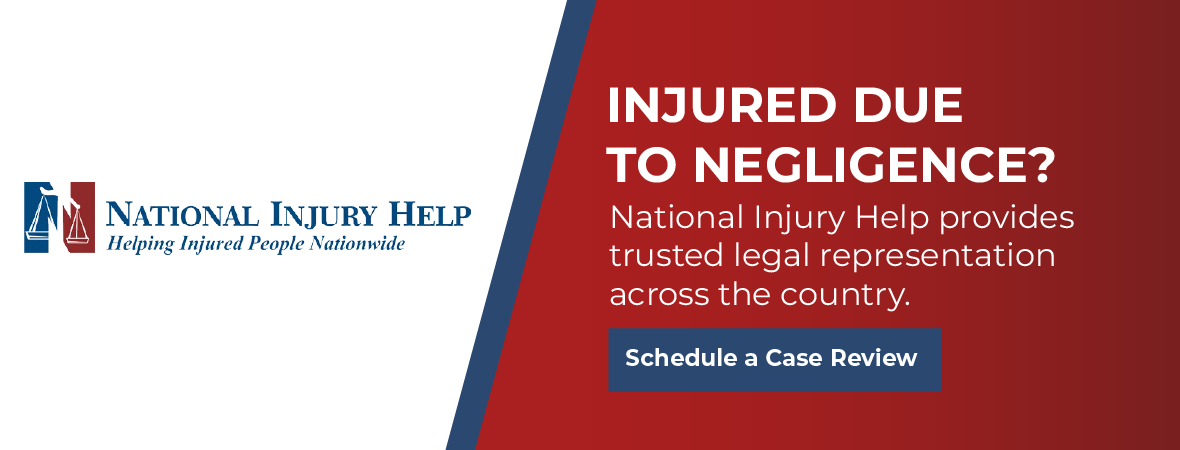Legal cases can feel overwhelming after a crash. This article breaks the process down step by step so you know what to expect. Whether you are recovering from a car accident or any serious injury, National Injury Help is ready to handle the legal side while you focus on healing.
A car accident can disrupt your day and your life without warning. One moment you’re on the road, heading to work or running errands, and the next you’re pulled over, trying to figure out what just happened.
Your mind races with questions about your safety, your car, and what comes next. In those early moments, the steps you take can have a big impact on how quickly you recover, both physically and financially.
Even though traffic and insurance laws vary from state to state, the general path for handling a crash is similar no matter where you live. From gathering information at the scene to filing an insurance claim, seeking medical care, and deciding whether to hire a lawyer, there’s a process that helps protect your rights and guides you toward fair compensation.
This guide will walk you through each stage. You’ll learn what to do right after an accident, how to deal with insurance companies, when legal help makes sense, and what to expect if your claim isn’t resolved quickly. Whether your case ends with a settlement or moves toward trial, having a clear plan gives you confidence and helps you move forward with less stress.
At National Injury Help, we provide legal help for crash victims across the nation, and we help them navigate the court process after an accident.
Step 1: Actions to Take Immediately After the Crash
There are some actions to take immediately after a car accident to protect your rights.
A. Keep Everyone Safe and Call for Help
- Breathe and scan for danger. If the vehicle still rolls, ease it onto the shoulder or a nearby parking lot so traffic does not cause a second crash.
- Flip on your hazard lights and set out reflective triangles or flares if you carry them.
- Dial 911. In every state, police should be called if anyone complains of pain, vehicles block the road, or property damage looks expensive. A formal police report becomes the backbone of your insurance claim.
B. Collect Evidence Before It Disappears
- Grab your cell phone and take crisp photos: wide shots showing all vehicles, close-ups of dents and shattered lamps, skid marks, spilled oil, torn guardrails, and road signs.
- Exchange the basics with every driver, full name, mailing address, driver’s license number, license plate number, and insurance information.
- When kind strangers ask, “Are you okay?” reply, “Thanks, could I text you later if you saw the accident?” Neutral witnesses often nudge insurers toward a fair payout.
C. Get a Medical Check-Up, Even If You “Feel Fine”
Low-speed impacts can sprain neck ligaments, jolt the brain, or bruise organs without immediate pain. Paramedics can rule out emergencies at the scene, but visit an urgent-care clinic or emergency room within 24 hours. The sooner a doctor links your symptoms to the collision, the harder it is for an adjuster to claim you were hurt somewhere else.
Step 2: Notify Insurance
It is also important to notify your insurance company of the accident.
A. Understanding Fault and No-Fault Systems
- Most states (e.g., Texas, Illinois, Washington) use a fault system. The driver who caused the crash, or, more accurately, that driver’s insurer, pays for repairs, medical bills, and lost wages.
- A handful of states (e.g., Florida, Michigan, New York) follow no-fault rules. Here, you first tap your own Personal Injury Protection (PIP) policy, regardless of blame, up to a set dollar cap.
Because the rules shift at state lines, open a claim with both your insurer and the other driver’s carrier as soon as practical, ideally within one or two days. Your policy may front money under collision, med-pay, or PIP coverage and later seek reimbursement from the at-fault party.
B. Handle Adjusters With Caution
Within hours, a friendly-sounding adjuster may phone you “just to get your version of events.” Remember, their paycheck depends on paying out less, not more.
- Stay polite but brief. Confirm the date, time, location, and number of vehicles.
- Decline a recorded statement until you have spoken with a lawyer or, at minimum, had time to gather your thoughts.
- Never guess. If you are unsure of your exact speed or whether a light was yellow or red, say so. A casual “I might have been going a little fast” can shrink your settlement by thousands.
Step 3: Decide Whether to Call a Personal Injury Lawyer
It’s also a crucial step, and a question worth asking yourself.
A. Red Flags That Mean “Call Today”
- Ambulance ride or hospital admission
- Multiple vehicles, a semi-truck, or a rideshare company are involved
- The other driver’s insurer stops returning calls
- Permanent injuries, potential surgery, or months of physical therapy ahead
B. How a Lawyer Makes Life Easier
An attorney becomes a buffer between you, adjusters, hospital billing departments, and aggressive defense counsel.
They know deadlines (statutes of limitation range from one year in Kentucky to six years in Maine), understand partial-fault rules, and build a demand package that includes future therapy, wheelchair ramps, or lost promotional opportunities at work. While they talk on the phone, you focus on doctor visits and getting life back on track.
Step 4: Deep-Dive Investigation
Your legal team, or you, if you go it alone, now turns detective:
- Order the full police report and emergency-dispatch audio.
- Retrieve traffic-camera video or dash-cam footage before it loops over.
- Download “black-box” data from modern vehicles that logs speed, throttle, and braking seconds before impact.
- Gather medical records, mileage receipts for doctor visits, and pay stubs showing missed income.
- When the fault is murky, hire accident-reconstruction engineers or medical specialists to write opinions.
This phase may wrap up in a month for straightforward fender-benders or stretch into a year for catastrophic injuries with ongoing treatment.
Step 5: The Demand Letter and Negotiation Dance
Once the evidence binder is airtight, your attorney writes a demand letter that:
- Explains how the crash happened in plain language, backed by photos and diagrams.
- Lists every dollar already spent for ambulance rides, CT scans, rental cars, and child-care help.
- Forecasts future costs for surgery, physical therapy, or long-term medication.
- Calculates lost earnings and lost future promotions or gig-economy income.
- States a lump-sum figure that fully and fairly compensates you, leaving room to bargain.
Insurers nearly always reply with a lower amount. Think of negotiations as a seesaw: offers rise and fall, clarifications flow in writing, and sometimes a settlement conference brings everyone into one room (or video call). Statistics show that most claims are resolved here, sparing both sides the risk and expense of court.
Step 6: Filing a Lawsuit, The Back-Up Plan
A. Watch the Clock
Every state sets a filing deadline called the statute of limitations. Miss it, even by one day, and the court must dismiss your case. Common deadlines include:
- Two years: California, Georgia, Pennsylvania
- Three years: Colorado, Massachusetts, South Carolina
- Four years: Nebraska, Nevada, Utah
If a city snow-plow or a federal mail truck hit you, additional notice rules, sometimes as short as 90 to 180 days, apply. Call a lawyer early.
B. What “Going to Court” Really Looks Like
- Complaint filed: Served on each defendant.
- Discovery phase: Both sides exchange documents, submit written questions (interrogatories), and take sworn depositions of drivers, doctors, and experts.
- Pre-trial motions: Aims to toss weak evidence or force the other side to turn over missing files.
- Mediation or arbitration: Often required by the judge as a last-ditch settlement effort.
- Trial: A judge or jury decides fault and fair monetary damages. Verdicts can exceed any pre-trial offer, yet losing is always possible, so weigh offers carefully with your attorney.
Only a small slice of cases, roughly 3%, ever see a courtroom, but preparing as if yours will be that 3% gives you bargaining power.
Step 7: Life After Settlement or Judgment
The insurance company typically issues a check within 30 days of signing a release agreement. Medical liens and legal fees are paid first, then the balance goes to you.
Use part to create a financial cushion: set aside cash for future therapy, save receipts, and keep a copy of every settlement document. Accidents create paperwork that can matter again when refinancing a car, applying for new insurance, or filing taxes.
Contact a Car Accident Lawyer
The gap between a rushed insurance payout and fair compensation can be wide. If you were hurt in a crash, let National Injury Help guide you through the car accident lawsuit process, from gathering evidence on day one to negotiating with adjusters and, if necessary, presenting your case before a jury.
The consultation costs nothing, and you pay no legal fee unless we recover money on your behalf. Reach out today by calling 1 (800) 214-1010, and put a dedicated team on your side while you focus on healing. Let us help you get the justice you deserve.







